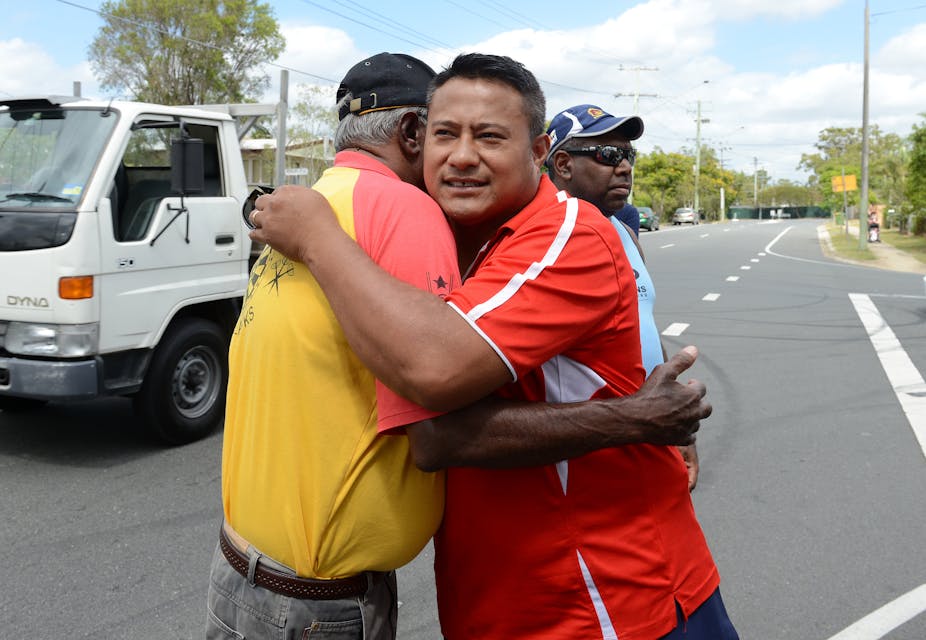Every city has them - the neighbourhoods that everyone else looks down on.
In Australia, Sydney has “Westies”. Brisbane has “Logan bogans”. And in Melbourne, the western suburb of Sunshine is colloquially referred to as “Scumshine”. These areas are commonly characterised as problem places, inhabited by “problem people”.
So when something goes wrong in these areas - as it did last month in Logan City, where tensions between young Indigenous and Pacific Islanders bubbled over into four days of violent clashes - it’s easy for the rest of us living outside those areas to roll our eyes and look the other way.
Defined by where you’re from
A Google search for where to live in Brisbane reveals that many of the “worst” suburbs are in Logan City, including Woodridge where the clashes occurred. The online urban dictionary includes this defintion of “bogan”: “anyone from the locality in Queensland known as Logan City. Look at that new kid. He lives in Logan, such a bogan!”
Our perceptions of what makes a good or bad neighbourhood extend beyond crime and visible signs of disorder and decay, such as graffiti, garbage and broken windows.
Instead, criminological studies find that the problems we “see” are strongly associated with the presence of particular minority groups living in the neighbourhood. These negative associations are known as “implicit biases”. And they matter because they can affect people’s lives.
In the case of Logan, one of Australia’s most ethnically diverse areas, the recent clashes have unfortunately reinforced public perceptions of it as a racially-divided city, where high levels of unemployment and crime abound.
There is some truth to this characterisation: levels of disadvantage are higher in Logan than the national average and violent crime rates are high. But our association of Logan City and crime is, at least in part, biased.
How implicit biases shape our behaviour
Unlike stereotypes, which represent either positive or negative associations between a social group and a given trait, implicit biases occur when attitudes, attributions or stereotypes compromise the accuracy and fairness of judgments. They operate without us being aware of them, are widely held in society, and are predictive of discriminatory behaviour. Federal MP Andrew Laming’s tweet at the height of the clashes - “Mobs tearing up Logan. Did any of them do a day’s work today, or was it business as usual and welfare on tap?” - is a case in point.
Implicit biases are the result of everyday personal observations, which are then exaggerated or applied to an entire group of people. For example, studies in the United States show that white residents who believe they live close to black residents will report higher levels of fear of crime than those living further away.
There is significant evidence indicating that implicit bias is alive and well in Australia too. For example, Indigenous Australians are perceived as welfare-dependent, substance-addicted and are associated with problems of crime and disorder.

In a recent study of nearly 10,000 Brisbane and Melbourne residents living in 300 suburbs, a team of colleagues and I revealed how widespread implicit bias is in Australia. Using data from the [Australian Community Capacity Study](http://www.uq.edu.au/accs/](http://www.uq.edu.au/accs/), we found that residents are more likely to perceive problems such as public drinking, loitering and drug use when they overestimated the number of non-Anglo-Saxons living in their suburb.
When people saw more Muslim and Indigenous Australians, they perceived more disorder - irrespective of the neighbourhood’s actual socio-economic status and rate of violent crime. Interestingly, people in Brisbane were more likely to associate ethnic diversity with crime and disorder than people in Melbourne.
The practical impacts of implicit bias
As the Australian Community Capacity Study and other research demonstrate, implicit biases matter because they can make disadvantaged people’s lives tougher.
Our implicit biases can reinforce disadvantage and disinvestment in certain neighbourhoods, as the racial, ethnic and class compositions of an area become strongly associated with social problems and “types” of people.
Such associations negatively impact upon the people who live in these neighbourhoods. Residents living in places with unfavourable reputations report lower well-being, self-esteem and feelings of trust.
However, the negative association between “problem people” and “problem places” can be changed. In our study, for example, we found that there was less implicit bias in suburbs where people trusted each other and shared common values.
Why prejudice is everyone’s problem
Though the local council is doing what they can to improve the quality of life for Logan City residents, it remains an area that is over-burdened by inequality and increasing ethnic concentration. It is home to populations with multiple and complex needs, yet there are limited resources to foster full participation in society.
Instead of examining the underlying conditions that lead to social problems - such as concentrated disadvantage, cuts to important government services, and the gap between the rich and the poor - it is easier to reduce Logan’s “crime problem” to a racial divide between Indigenous and Pacific Islander residents.
Yet this will only serve to reinforce the problem. By mistakenly attributing what happened in Logan to the “mobs” that live there, we fail to recognise and respond to the broader social forces that lead to the clustering of violence in disadvantaged areas.

